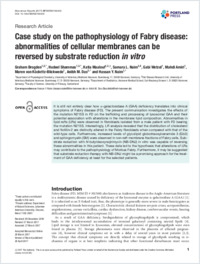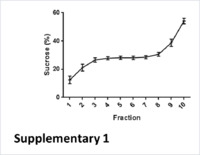Case study on the pathophysiology of Fabry disease: abnormalities of cellular membranes can be reversed by substrate reduction in vitro
- Brogden, Graham Department of Physiological Chemistry, University of Veterinary Medicine Hannover, Germany - Fish Disease Research Unit, University of Veterinary Medicine Hannover, Germany
- Shammas, Hadeel Department of Physiological Chemistry, University of Veterinary Medicine Hannover, Germany - Department of Paediatrics, Hannover Medical School, Hannover, Germany
- Maalouf, Katia Department of Physiological Chemistry, University of Veterinary Medicine Hannover, Germany - Department of Paediatrics, Hannover Medical School, Hannover, Germany
- Naim, Samara L. Department of Paediatrics, Hannover Medical School, Hannover, Germany - Faculty of Science, University of Fribourg, Switzerland
- Wetzel, Gabi Department of Physiological Chemistry, University of Veterinary Medicine Hannover, Germany
- Amiri, Mahdi Department of Physiological Chemistry, University of Veterinary Medicine Hannover, Germany
- Köckritz-Blickwede, Maren von Department of Physiological Chemistry, University of Veterinary Medicine Hannover, Germany
- Das, Anibh M. Department of Paediatrics, Hannover Medical School, Hannover, Germany
- Naim, Hassan Y. Department of Physiological Chemistry, University of Veterinary Medicine Hannover, Germany
-
30.04.2017
Published in:
- Bioscience Reports. - 2017, vol. 37, no. 2, p. BSR20160402
English
It is still not entirely clear how α-galactosidase A (GAA) deficiency translates into clinical symptoms of Fabry disease (FD). The present communication investigates the effects of the mutation N215S in FD on the trafficking and processing of lysosomal GAA and their potential association with alterations in the membrane lipid composition. Abnormalities in lipid rafts (LRs) were observed in fibroblasts isolated from a male patient with FD bearing the mutation N215S. Interestingly, LR analysis revealed that the distribution of cholesterol and flotillin-2 are distinctly altered in the Fabry fibroblasts when compared with that of the wild-type cells. Furthermore, increased levels of glycolipid globotriaosylceramide 3 (Gb3) and sphingomyelin (SM) were observed in non-raft membrane fractions of Fabry cells. Substrate reduction with N-butyldeoxynojirimycin (NB-DNJ) in vitro was capable of reversing these abnormalities in this patient. These data led to the hypothesis that alterations of LRs may contribute to the pathophysiology of Morbus Fabry. Furthermore, it may be suggested that substrate reduction therapy with NB-DNJ might be a promising approach for the treatment of GAA deficiency at least for the selected patients.
- Faculty
- Faculté des sciences et de médecine
- Department
- Département de Médecine
- Language
-
- English
- Classification
- Biological sciences
- License
-
License undefined
- Identifiers
-
- RERO DOC 305103
- DOI 10.1042/BSR20160402
- Persistent URL
- https://folia.unifr.ch/unifr/documents/305982
Other files
Statistics
Document views: 73
File downloads:
- pdf: 172
- Supplementary material: 123

